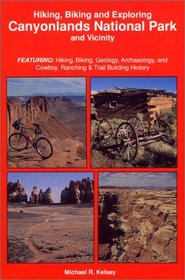Search -
Hiking, Biking and Exploring Canyonlands National Park and Vicinity : Hikng, Biking, Geology, Archaeology, and Cowboy, Ranching Trail Building History
Hiking Biking and Exploring Canyonlands National Park and Vicinity Hikng Biking Geology Archaeology and Cowboy Ranching Trail Building History
Author:
The emphasis of the book is on hiking in Canyonlands National Park & vicinity of eastern Utah. This park is located west of Moab and south of the town of Green River, in the area where the Green and the Coloardo Rivers meet--locally known as The Confluence. But because not everyone has a 4WD vehicle, the author tells where a mountain bike can ... more »
Author:
The emphasis of the book is on hiking in Canyonlands National Park & vicinity of eastern Utah. This park is located west of Moab and south of the town of Green River, in the area where the Green and the Coloardo Rivers meet--locally known as The Confluence. But because not everyone has a 4WD vehicle, the author tells where a mountain bike can ... more »
ISBN-13: 9780944510087
ISBN-10: 0944510086
Publication Date: 5/1992
Pages: 320
Rating: ?
ISBN-10: 0944510086
Publication Date: 5/1992
Pages: 320
Rating: ?
0 stars, based on 0 rating
Publisher: Kelsey Publishing (Utah)
Book Type: Paperback
Members Wishing: 1
Reviews: Amazon | Write a Review
Book Type: Paperback
Members Wishing: 1
Reviews: Amazon | Write a Review
Genres:
- Reference >> General
- Travel >> Food, Lodging & Transportation >> Parks & Campgrounds
- Travel >> United States >> Regions >> West >> Mountain
- Travel >> United States >> States >> Utah >> General
- Outdoors & Nature >> Hiking & Camping >> Excursion Guides >> General
- Outdoors & Nature >> Hiking & Camping >> Excursion Guides >> United States >> Utah




